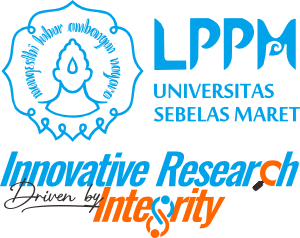Key words : Chitosan, Deacetylation, Swelling, Crosslingking
By: Budi Hastuti and Abu Masykur
The isolation and modification of chitosan from Ballemnya javanica shells and its application as a selective adsorbent selective for heavy metal Cr (VI) in batik industrial waste were conducted.
Initially, Ballemnya javanica shells powder was deproteinated using 4% NaOH to remove protein, and demineralized using 2 M HCl to remove minerals. The powder obtained is called chitin. Subsequently, chitin deacetylation using 50% NaOH was conducted to obtain chitosan. At this stage, the time of deacetylation was varied, which is 3, 5, and 8 hours. Various stages of deacetylation was also done, which is 1, 2, and 3 stages. Then chitosan was modified through a process of swelling, to open the pores, followed by crosslingking with glutaraldehyde and epichlorohydrin as crosslingker, with various concentration of 8, 10, 20, and 25%. Finally, the modified chitosan was contacted with the Cr (VI) to test the ability of adsorption with variation of pH and contact time. Application of modified chitosan was done in batik industrial waste containing Cr (IV).
From the chitin characterization using IR, OH functional groups at λ 3449 nm and amide groups at λ 1651 nm were obtained. The DD (degree of deacetylation) of chitin was found 38%. Chitosan deacetylation through a gradual steps of deacetylation had a higher DD than that only through one step. Chitosan through 3 deacetylation steps had the DD of 88%, compared to 84% in 2 steps and 67% in 1 step of deacetylation. Nevertheless, by extending the time of deacetylation up to 8 hours, resulting in DD of 82%, which then becomes the reference condition for chitosan deacetylation. In chitosan modification, the optimum condition was obtained by using crosslingker glutaraldehyde 25% (v/v) and epichlorohydrin 25% (v/v). Nevertheless, epichlorohydrin has advantages over glutaraldehyde on the nature of resistance to acids, even at a very strong acidic conditions. Modified chitosan could improve the adsorption capacity of chitosan to Cr (VI) from 74% (raw chitosan) to 89% at contact time of 30 minutes and pH 3. On application to the batik waste, modified chitosan could sufficiently adsorb Cr (IV) up to the level of 5 ppm. Thus, the modified chitosan has the potential to be applied as an adsorbent of Cr (VI) in batik industrial waste.

